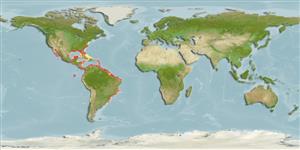Environment: milieu / climate zone / depth range / distribution range
Écologie
marin; saumâtre démersal; océanodrome (Ref. 51243); profondeur 0 - 100 m (Ref. 115829), usually 0 - 30 m (Ref. 5217). Subtropical; 11°C - 31°C (Ref. 47167); 40°N - 34°S, 117°W - 34°W
Eastern Central Pacific: Baja California to Peru (Ref. 9330); Northwestern Central Atlantic: Canada (Ref. 5951) to Chesapeake Bay, USA to the Antilles and southern Brazil.
Length at first maturity / Taille / Poids / Âge
Maturity: Lm 8.5, range 8 - ? cm
Max length : 21.3 cm TL mâle / non sexé; (Ref. 124487); common length : 15.0 cm TL mâle / non sexé; (Ref. 5217); poids max. publié: 64.40 g (Ref. 124487); âge max. reporté: 1.21 années (Ref. 47359)
Épines dorsales (Total): 0; Rayons mous dorsaux (Total): 73-87; Épines anales 0; Rayons mous anaux: 57 - 68
Inhabits sandy and muddy bottoms (Ref. 9330). Common in estuaries (Ref. 9330). Feeds on big, benthic invertebrates and small fishes (Ref. 9330). Utilized fresh (Ref. 9330).
Life cycle and mating behavior
Maturité | Reproduction | Frai | Œufs | Fécondité | Larves
Oviparous (Ref. 101737). Distinct pairing (Ref. 205). Females produce numerous eggs in multiple spawnings during a prolonged spawning period (Ref. 101737).
Figueiredo, J.L. and N.A. Menezes, 2000. Manual de peixes marinhos do sudeste do Brasil. VI.Teleostei (5). Museu de Zoologia, Universidade de São Paulo. Brazil. 116 p. (Ref. 36453)
Statut dans la liste rouge de l'IUCN (Ref. 130435)
Menace pour l'homme
Harmless
Utilisations par l'homme
Pêcheries: intérêt commercial mineur
Plus d'informations
RéférencesAquacultureProfil d'aquacultureSouchesGénétiqueElectrophoresesHéritabilitéPathologiesTraitementNutrientsMass conversion
Outils
Articles particuliers
Télécharger en XML
Sources Internet
Estimates based on models
Preferred temperature (Ref.
123201): 21.1 - 28, mean 25.7 °C (based on 862 cells).
Phylogenetic diversity index (Ref.
82804): PD
50 = 0.5020 [Uniqueness, from 0.5 = low to 2.0 = high].
Bayesian length-weight: a=0.00832 (0.00661 - 0.01047), b=3.10 (3.03 - 3.17), in cm total length, based on LWR estimates for this species (Ref.
93245).
Niveau trophique (Ref.
69278): 3.5 ±0.1 se; based on diet studies.
Generation time: 2.4 ( na - na) years. Estimated as median ln(3)/K based on 2
growth studies.
Résilience (Ref.
120179): Haut, temps minimum de doublement de population inférieur à 15 mois (tmax=1.2; k >0.3).
Fishing Vulnerability (Ref.
59153): Low vulnerability (11 of 100).
Nutrients (Ref.
124155): Calcium = 191 [89, 438] mg/100g; Iron = 1.64 [0.75, 3.24] mg/100g; Protein = 17.7 [15.6, 19.8] %; Omega3 = 0.244 [0.120, 0.523] g/100g; Selenium = 36.6 [16.0, 86.1] μg/100g; VitaminA = 4.61 [1.15, 21.44] μg/100g; Zinc = 1.06 [0.66, 1.63] mg/100g (wet weight);
